Analyzing Japanese Military Accounts of the Second Sino-Japanese War
VerifiedAdded on 2022/10/02
|11
|2840
|437
Essay
AI Summary
This essay delves into the Second Sino-Japanese War by examining the wartime accounts of Japanese military personnel. It analyzes how mobilization strategies influenced the development of national consensus and purpose. The essay explores personal experiences of soldiers, highlighting their emotional responses to the war, the impact of their home front interactions, and their observations of the conflict's intensity and the Chinese resistance. It also considers the role of propaganda and the changing expectations of civilians, including children. The essay aims to provide insights into the complexities of the war, the motivations of the soldiers, and the broader socio-political impacts of the conflict.
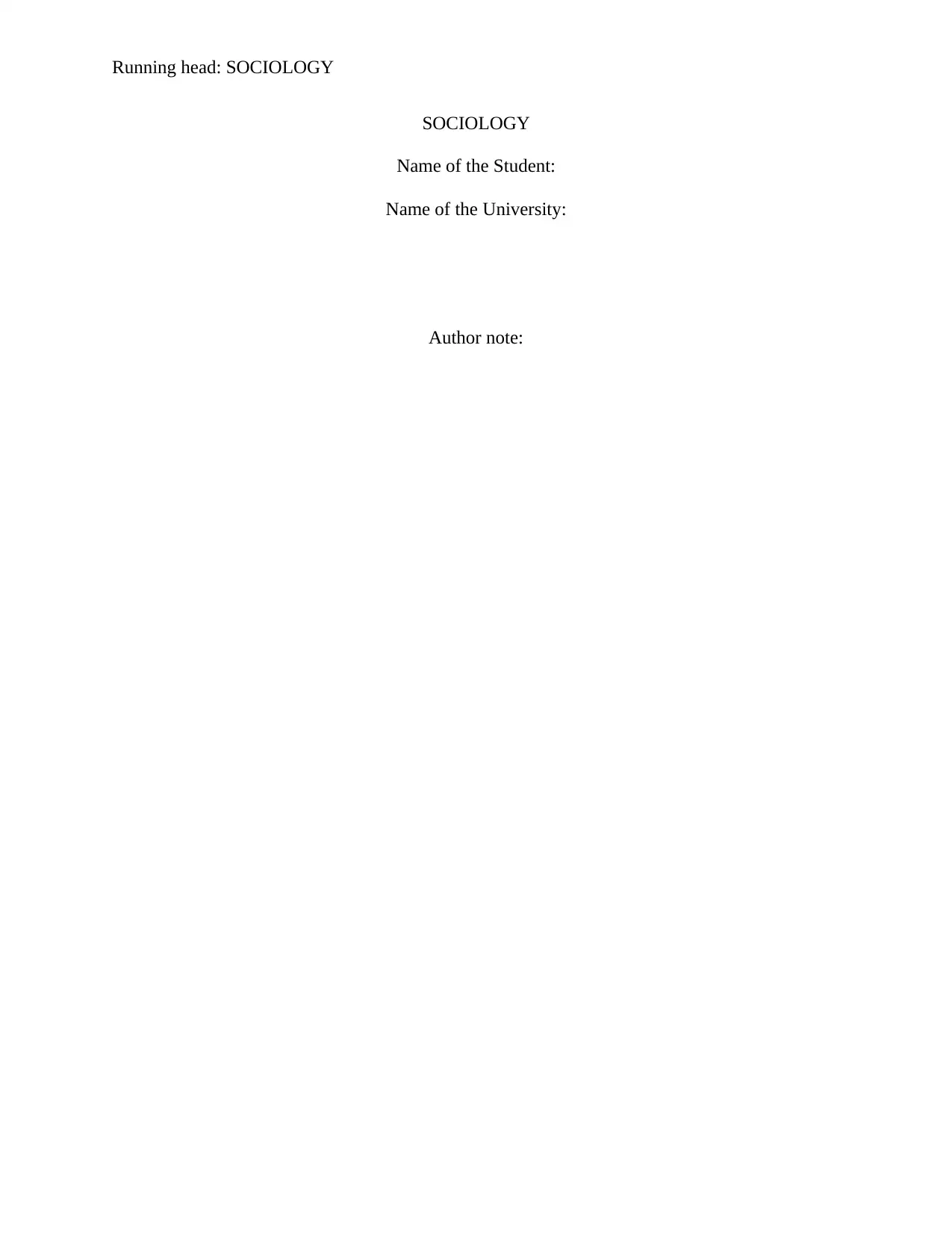
Running head: SOCIOLOGY
SOCIOLOGY
Name of the Student:
Name of the University:
Author note:
SOCIOLOGY
Name of the Student:
Name of the University:
Author note:
Paraphrase This Document
Need a fresh take? Get an instant paraphrase of this document with our AI Paraphraser
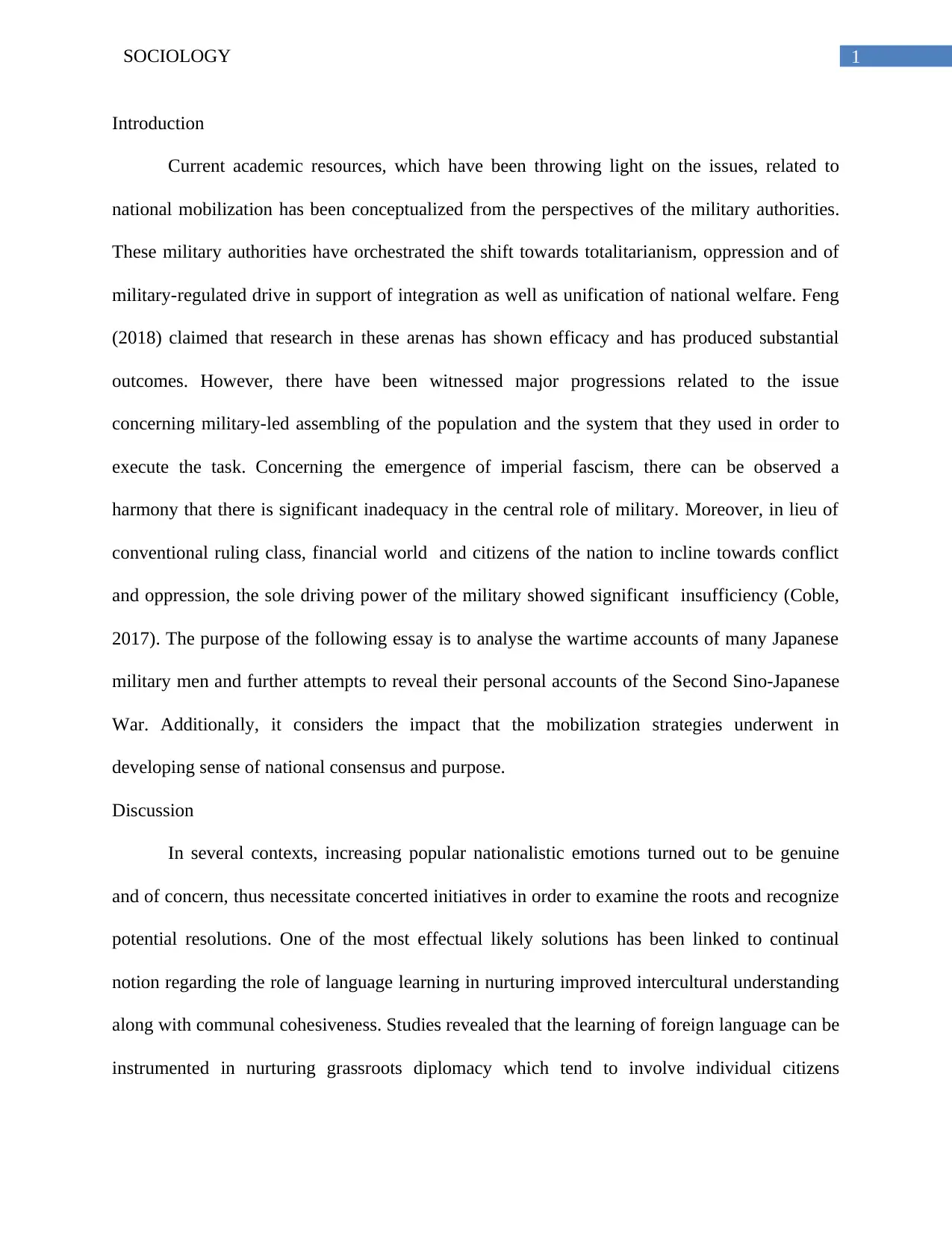
1SOCIOLOGY
Introduction
Current academic resources, which have been throwing light on the issues, related to
national mobilization has been conceptualized from the perspectives of the military authorities.
These military authorities have orchestrated the shift towards totalitarianism, oppression and of
military-regulated drive in support of integration as well as unification of national welfare. Feng
(2018) claimed that research in these arenas has shown efficacy and has produced substantial
outcomes. However, there have been witnessed major progressions related to the issue
concerning military-led assembling of the population and the system that they used in order to
execute the task. Concerning the emergence of imperial fascism, there can be observed a
harmony that there is significant inadequacy in the central role of military. Moreover, in lieu of
conventional ruling class, financial world and citizens of the nation to incline towards conflict
and oppression, the sole driving power of the military showed significant insufficiency (Coble,
2017). The purpose of the following essay is to analyse the wartime accounts of many Japanese
military men and further attempts to reveal their personal accounts of the Second Sino-Japanese
War. Additionally, it considers the impact that the mobilization strategies underwent in
developing sense of national consensus and purpose.
Discussion
In several contexts, increasing popular nationalistic emotions turned out to be genuine
and of concern, thus necessitate concerted initiatives in order to examine the roots and recognize
potential resolutions. One of the most effectual likely solutions has been linked to continual
notion regarding the role of language learning in nurturing improved intercultural understanding
along with communal cohesiveness. Studies revealed that the learning of foreign language can be
instrumented in nurturing grassroots diplomacy which tend to involve individual citizens
Introduction
Current academic resources, which have been throwing light on the issues, related to
national mobilization has been conceptualized from the perspectives of the military authorities.
These military authorities have orchestrated the shift towards totalitarianism, oppression and of
military-regulated drive in support of integration as well as unification of national welfare. Feng
(2018) claimed that research in these arenas has shown efficacy and has produced substantial
outcomes. However, there have been witnessed major progressions related to the issue
concerning military-led assembling of the population and the system that they used in order to
execute the task. Concerning the emergence of imperial fascism, there can be observed a
harmony that there is significant inadequacy in the central role of military. Moreover, in lieu of
conventional ruling class, financial world and citizens of the nation to incline towards conflict
and oppression, the sole driving power of the military showed significant insufficiency (Coble,
2017). The purpose of the following essay is to analyse the wartime accounts of many Japanese
military men and further attempts to reveal their personal accounts of the Second Sino-Japanese
War. Additionally, it considers the impact that the mobilization strategies underwent in
developing sense of national consensus and purpose.
Discussion
In several contexts, increasing popular nationalistic emotions turned out to be genuine
and of concern, thus necessitate concerted initiatives in order to examine the roots and recognize
potential resolutions. One of the most effectual likely solutions has been linked to continual
notion regarding the role of language learning in nurturing improved intercultural understanding
along with communal cohesiveness. Studies revealed that the learning of foreign language can be
instrumented in nurturing grassroots diplomacy which tend to involve individual citizens
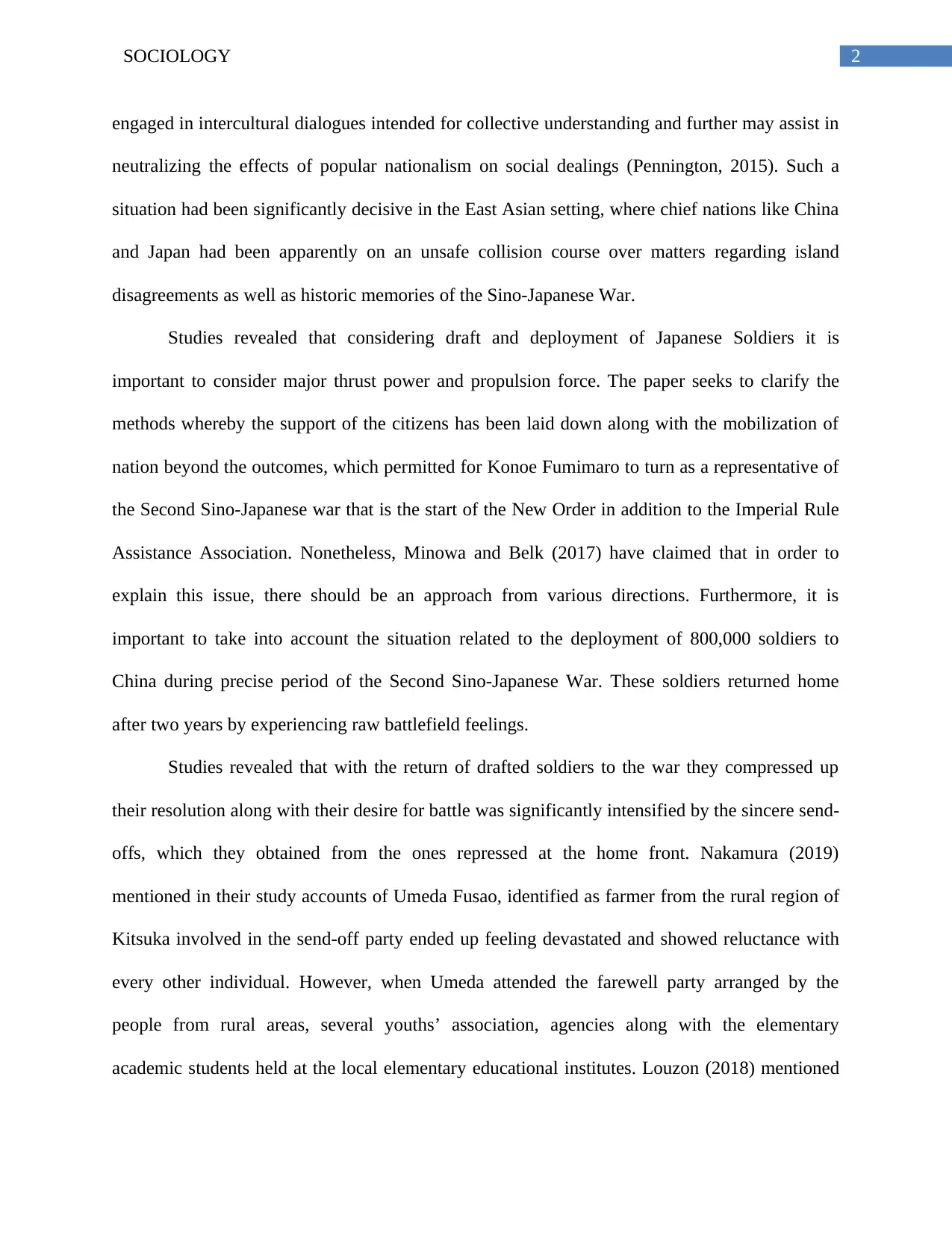
2SOCIOLOGY
engaged in intercultural dialogues intended for collective understanding and further may assist in
neutralizing the effects of popular nationalism on social dealings (Pennington, 2015). Such a
situation had been significantly decisive in the East Asian setting, where chief nations like China
and Japan had been apparently on an unsafe collision course over matters regarding island
disagreements as well as historic memories of the Sino-Japanese War.
Studies revealed that considering draft and deployment of Japanese Soldiers it is
important to consider major thrust power and propulsion force. The paper seeks to clarify the
methods whereby the support of the citizens has been laid down along with the mobilization of
nation beyond the outcomes, which permitted for Konoe Fumimaro to turn as a representative of
the Second Sino-Japanese war that is the start of the New Order in addition to the Imperial Rule
Assistance Association. Nonetheless, Minowa and Belk (2017) have claimed that in order to
explain this issue, there should be an approach from various directions. Furthermore, it is
important to take into account the situation related to the deployment of 800,000 soldiers to
China during precise period of the Second Sino-Japanese War. These soldiers returned home
after two years by experiencing raw battlefield feelings.
Studies revealed that with the return of drafted soldiers to the war they compressed up
their resolution along with their desire for battle was significantly intensified by the sincere send-
offs, which they obtained from the ones repressed at the home front. Nakamura (2019)
mentioned in their study accounts of Umeda Fusao, identified as farmer from the rural region of
Kitsuka involved in the send-off party ended up feeling devastated and showed reluctance with
every other individual. However, when Umeda attended the farewell party arranged by the
people from rural areas, several youths’ association, agencies along with the elementary
academic students held at the local elementary educational institutes. Louzon (2018) mentioned
engaged in intercultural dialogues intended for collective understanding and further may assist in
neutralizing the effects of popular nationalism on social dealings (Pennington, 2015). Such a
situation had been significantly decisive in the East Asian setting, where chief nations like China
and Japan had been apparently on an unsafe collision course over matters regarding island
disagreements as well as historic memories of the Sino-Japanese War.
Studies revealed that considering draft and deployment of Japanese Soldiers it is
important to consider major thrust power and propulsion force. The paper seeks to clarify the
methods whereby the support of the citizens has been laid down along with the mobilization of
nation beyond the outcomes, which permitted for Konoe Fumimaro to turn as a representative of
the Second Sino-Japanese war that is the start of the New Order in addition to the Imperial Rule
Assistance Association. Nonetheless, Minowa and Belk (2017) have claimed that in order to
explain this issue, there should be an approach from various directions. Furthermore, it is
important to take into account the situation related to the deployment of 800,000 soldiers to
China during precise period of the Second Sino-Japanese War. These soldiers returned home
after two years by experiencing raw battlefield feelings.
Studies revealed that with the return of drafted soldiers to the war they compressed up
their resolution along with their desire for battle was significantly intensified by the sincere send-
offs, which they obtained from the ones repressed at the home front. Nakamura (2019)
mentioned in their study accounts of Umeda Fusao, identified as farmer from the rural region of
Kitsuka involved in the send-off party ended up feeling devastated and showed reluctance with
every other individual. However, when Umeda attended the farewell party arranged by the
people from rural areas, several youths’ association, agencies along with the elementary
academic students held at the local elementary educational institutes. Louzon (2018) mentioned
⊘ This is a preview!⊘
Do you want full access?
Subscribe today to unlock all pages.

Trusted by 1+ million students worldwide
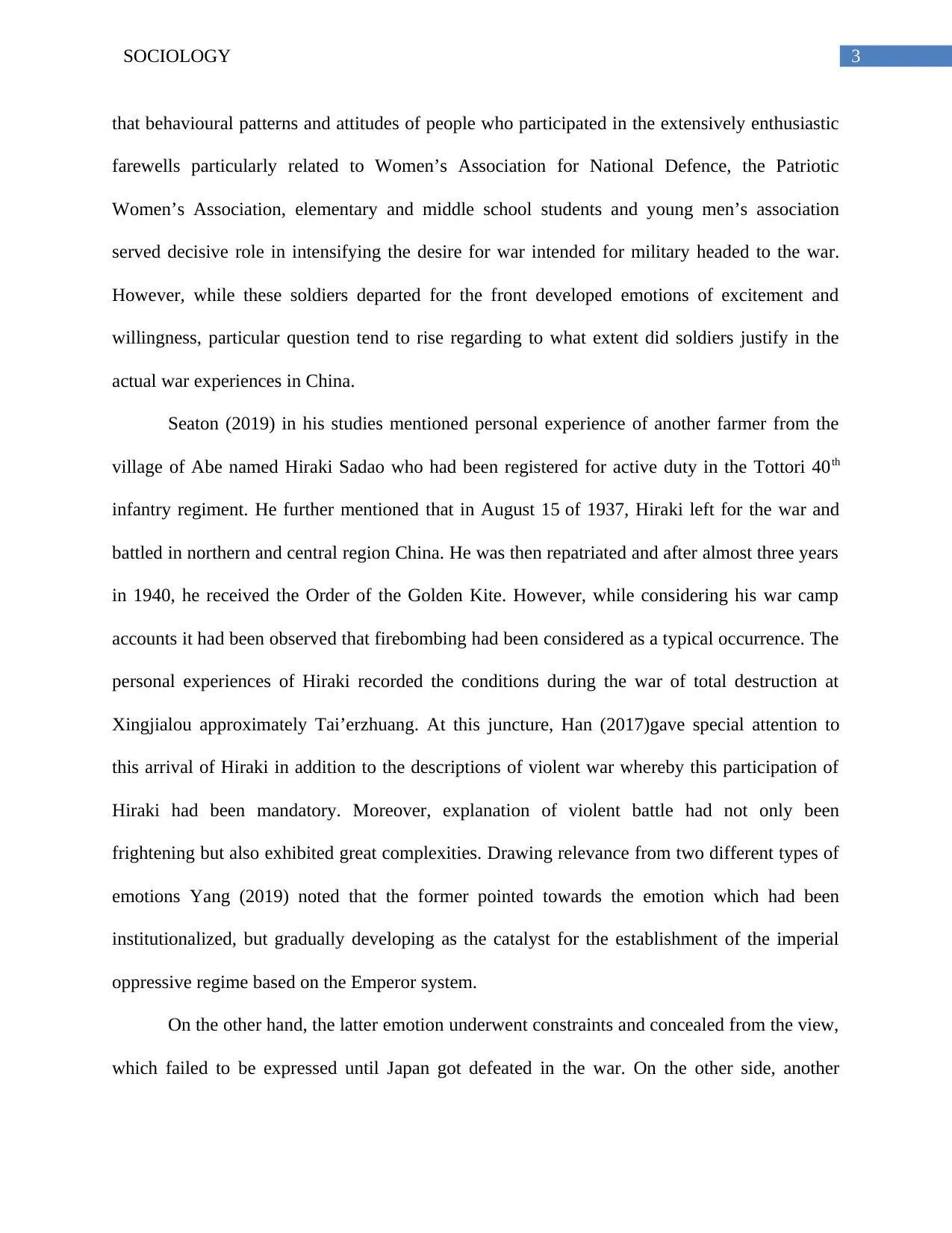
3SOCIOLOGY
that behavioural patterns and attitudes of people who participated in the extensively enthusiastic
farewells particularly related to Women’s Association for National Defence, the Patriotic
Women’s Association, elementary and middle school students and young men’s association
served decisive role in intensifying the desire for war intended for military headed to the war.
However, while these soldiers departed for the front developed emotions of excitement and
willingness, particular question tend to rise regarding to what extent did soldiers justify in the
actual war experiences in China.
Seaton (2019) in his studies mentioned personal experience of another farmer from the
village of Abe named Hiraki Sadao who had been registered for active duty in the Tottori 40th
infantry regiment. He further mentioned that in August 15 of 1937, Hiraki left for the war and
battled in northern and central region China. He was then repatriated and after almost three years
in 1940, he received the Order of the Golden Kite. However, while considering his war camp
accounts it had been observed that firebombing had been considered as a typical occurrence. The
personal experiences of Hiraki recorded the conditions during the war of total destruction at
Xingjialou approximately Tai’erzhuang. At this juncture, Han (2017)gave special attention to
this arrival of Hiraki in addition to the descriptions of violent war whereby this participation of
Hiraki had been mandatory. Moreover, explanation of violent battle had not only been
frightening but also exhibited great complexities. Drawing relevance from two different types of
emotions Yang (2019) noted that the former pointed towards the emotion which had been
institutionalized, but gradually developing as the catalyst for the establishment of the imperial
oppressive regime based on the Emperor system.
On the other hand, the latter emotion underwent constraints and concealed from the view,
which failed to be expressed until Japan got defeated in the war. On the other side, another
that behavioural patterns and attitudes of people who participated in the extensively enthusiastic
farewells particularly related to Women’s Association for National Defence, the Patriotic
Women’s Association, elementary and middle school students and young men’s association
served decisive role in intensifying the desire for war intended for military headed to the war.
However, while these soldiers departed for the front developed emotions of excitement and
willingness, particular question tend to rise regarding to what extent did soldiers justify in the
actual war experiences in China.
Seaton (2019) in his studies mentioned personal experience of another farmer from the
village of Abe named Hiraki Sadao who had been registered for active duty in the Tottori 40th
infantry regiment. He further mentioned that in August 15 of 1937, Hiraki left for the war and
battled in northern and central region China. He was then repatriated and after almost three years
in 1940, he received the Order of the Golden Kite. However, while considering his war camp
accounts it had been observed that firebombing had been considered as a typical occurrence. The
personal experiences of Hiraki recorded the conditions during the war of total destruction at
Xingjialou approximately Tai’erzhuang. At this juncture, Han (2017)gave special attention to
this arrival of Hiraki in addition to the descriptions of violent war whereby this participation of
Hiraki had been mandatory. Moreover, explanation of violent battle had not only been
frightening but also exhibited great complexities. Drawing relevance from two different types of
emotions Yang (2019) noted that the former pointed towards the emotion which had been
institutionalized, but gradually developing as the catalyst for the establishment of the imperial
oppressive regime based on the Emperor system.
On the other hand, the latter emotion underwent constraints and concealed from the view,
which failed to be expressed until Japan got defeated in the war. On the other side, another
Paraphrase This Document
Need a fresh take? Get an instant paraphrase of this document with our AI Paraphraser
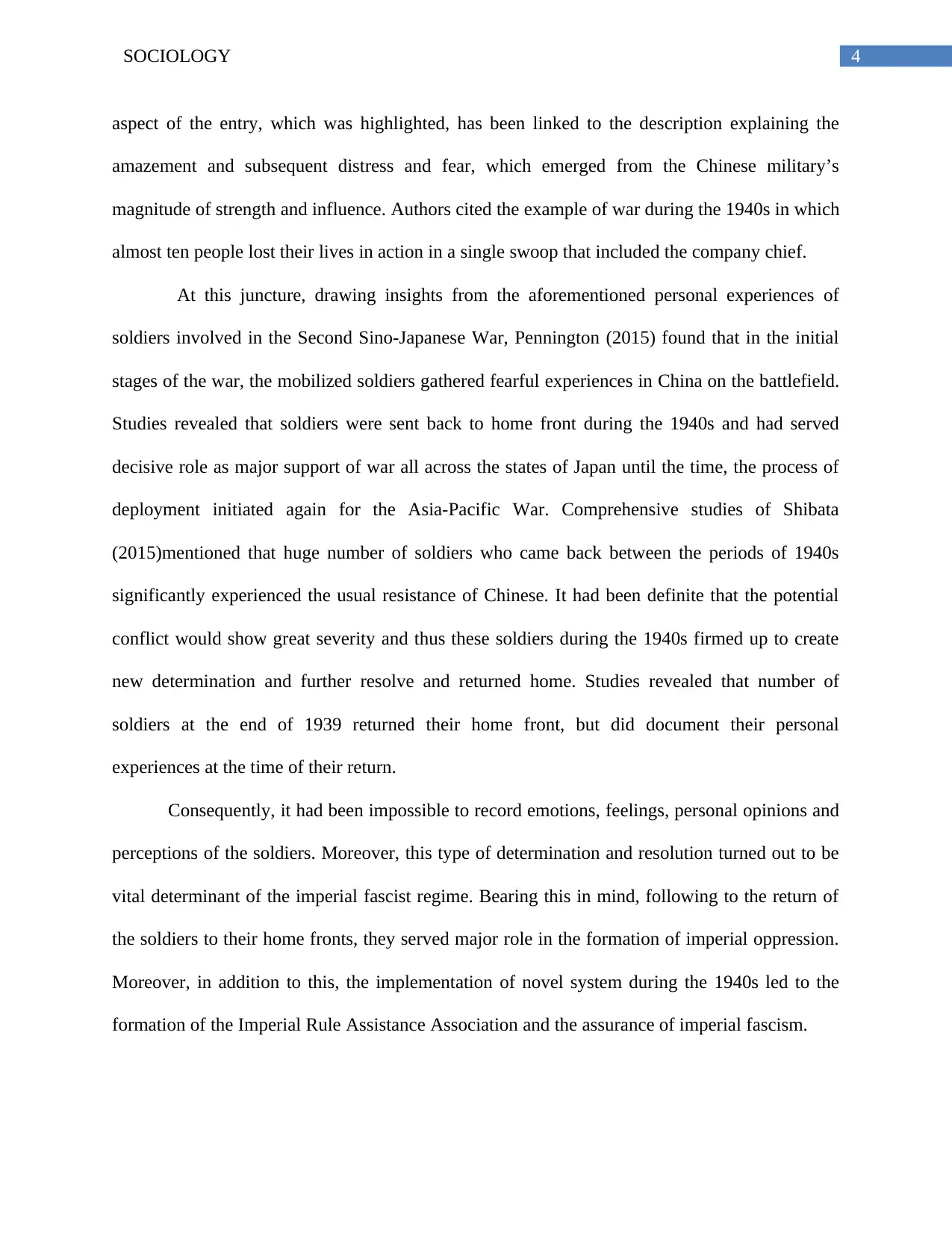
4SOCIOLOGY
aspect of the entry, which was highlighted, has been linked to the description explaining the
amazement and subsequent distress and fear, which emerged from the Chinese military’s
magnitude of strength and influence. Authors cited the example of war during the 1940s in which
almost ten people lost their lives in action in a single swoop that included the company chief.
At this juncture, drawing insights from the aforementioned personal experiences of
soldiers involved in the Second Sino-Japanese War, Pennington (2015) found that in the initial
stages of the war, the mobilized soldiers gathered fearful experiences in China on the battlefield.
Studies revealed that soldiers were sent back to home front during the 1940s and had served
decisive role as major support of war all across the states of Japan until the time, the process of
deployment initiated again for the Asia-Pacific War. Comprehensive studies of Shibata
(2015)mentioned that huge number of soldiers who came back between the periods of 1940s
significantly experienced the usual resistance of Chinese. It had been definite that the potential
conflict would show great severity and thus these soldiers during the 1940s firmed up to create
new determination and further resolve and returned home. Studies revealed that number of
soldiers at the end of 1939 returned their home front, but did document their personal
experiences at the time of their return.
Consequently, it had been impossible to record emotions, feelings, personal opinions and
perceptions of the soldiers. Moreover, this type of determination and resolution turned out to be
vital determinant of the imperial fascist regime. Bearing this in mind, following to the return of
the soldiers to their home fronts, they served major role in the formation of imperial oppression.
Moreover, in addition to this, the implementation of novel system during the 1940s led to the
formation of the Imperial Rule Assistance Association and the assurance of imperial fascism.
aspect of the entry, which was highlighted, has been linked to the description explaining the
amazement and subsequent distress and fear, which emerged from the Chinese military’s
magnitude of strength and influence. Authors cited the example of war during the 1940s in which
almost ten people lost their lives in action in a single swoop that included the company chief.
At this juncture, drawing insights from the aforementioned personal experiences of
soldiers involved in the Second Sino-Japanese War, Pennington (2015) found that in the initial
stages of the war, the mobilized soldiers gathered fearful experiences in China on the battlefield.
Studies revealed that soldiers were sent back to home front during the 1940s and had served
decisive role as major support of war all across the states of Japan until the time, the process of
deployment initiated again for the Asia-Pacific War. Comprehensive studies of Shibata
(2015)mentioned that huge number of soldiers who came back between the periods of 1940s
significantly experienced the usual resistance of Chinese. It had been definite that the potential
conflict would show great severity and thus these soldiers during the 1940s firmed up to create
new determination and further resolve and returned home. Studies revealed that number of
soldiers at the end of 1939 returned their home front, but did document their personal
experiences at the time of their return.
Consequently, it had been impossible to record emotions, feelings, personal opinions and
perceptions of the soldiers. Moreover, this type of determination and resolution turned out to be
vital determinant of the imperial fascist regime. Bearing this in mind, following to the return of
the soldiers to their home fronts, they served major role in the formation of imperial oppression.
Moreover, in addition to this, the implementation of novel system during the 1940s led to the
formation of the Imperial Rule Assistance Association and the assurance of imperial fascism.
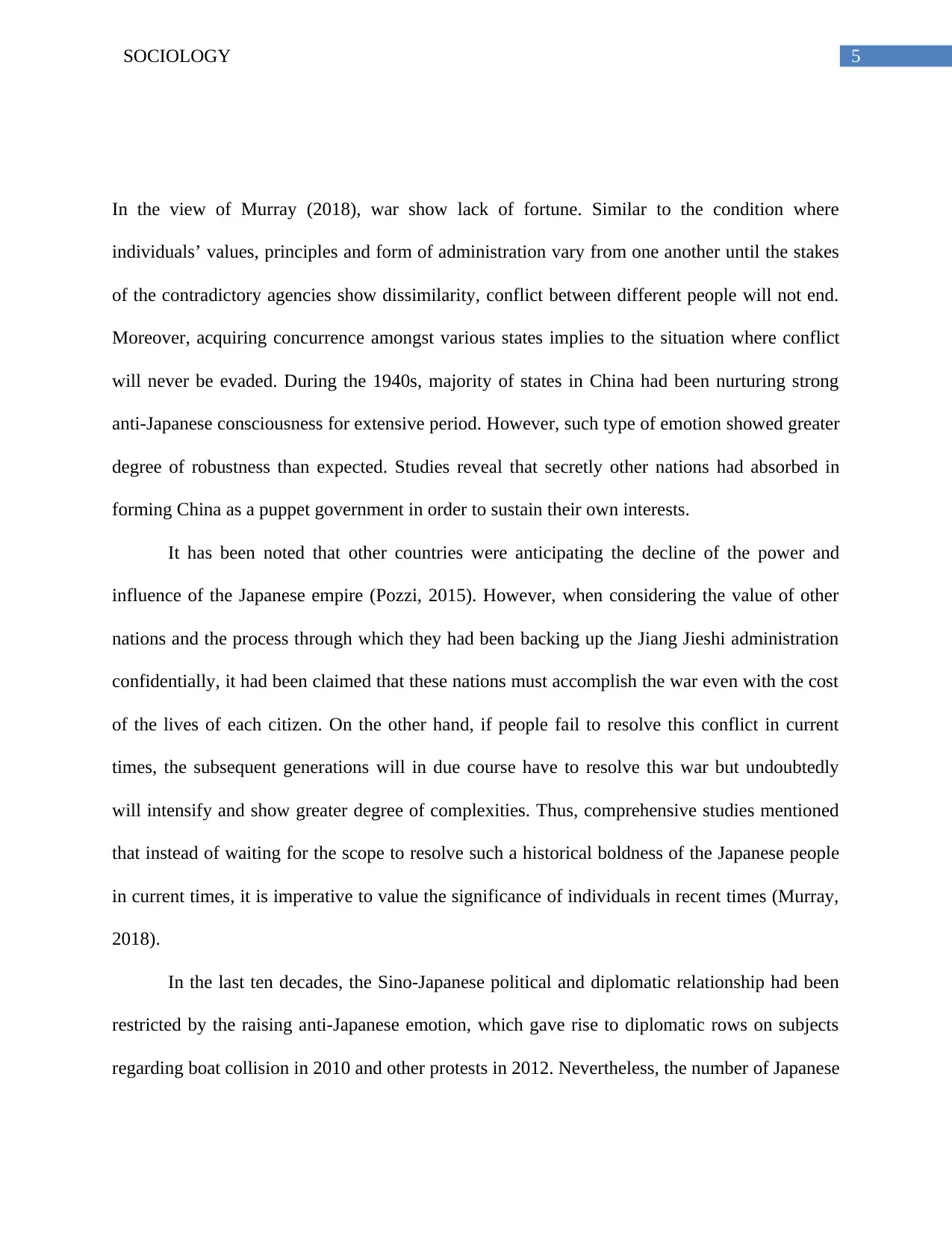
5SOCIOLOGY
In the view of Murray (2018), war show lack of fortune. Similar to the condition where
individuals’ values, principles and form of administration vary from one another until the stakes
of the contradictory agencies show dissimilarity, conflict between different people will not end.
Moreover, acquiring concurrence amongst various states implies to the situation where conflict
will never be evaded. During the 1940s, majority of states in China had been nurturing strong
anti-Japanese consciousness for extensive period. However, such type of emotion showed greater
degree of robustness than expected. Studies reveal that secretly other nations had absorbed in
forming China as a puppet government in order to sustain their own interests.
It has been noted that other countries were anticipating the decline of the power and
influence of the Japanese empire (Pozzi, 2015). However, when considering the value of other
nations and the process through which they had been backing up the Jiang Jieshi administration
confidentially, it had been claimed that these nations must accomplish the war even with the cost
of the lives of each citizen. On the other hand, if people fail to resolve this conflict in current
times, the subsequent generations will in due course have to resolve this war but undoubtedly
will intensify and show greater degree of complexities. Thus, comprehensive studies mentioned
that instead of waiting for the scope to resolve such a historical boldness of the Japanese people
in current times, it is imperative to value the significance of individuals in recent times (Murray,
2018).
In the last ten decades, the Sino-Japanese political and diplomatic relationship had been
restricted by the raising anti-Japanese emotion, which gave rise to diplomatic rows on subjects
regarding boat collision in 2010 and other protests in 2012. Nevertheless, the number of Japanese
In the view of Murray (2018), war show lack of fortune. Similar to the condition where
individuals’ values, principles and form of administration vary from one another until the stakes
of the contradictory agencies show dissimilarity, conflict between different people will not end.
Moreover, acquiring concurrence amongst various states implies to the situation where conflict
will never be evaded. During the 1940s, majority of states in China had been nurturing strong
anti-Japanese consciousness for extensive period. However, such type of emotion showed greater
degree of robustness than expected. Studies reveal that secretly other nations had absorbed in
forming China as a puppet government in order to sustain their own interests.
It has been noted that other countries were anticipating the decline of the power and
influence of the Japanese empire (Pozzi, 2015). However, when considering the value of other
nations and the process through which they had been backing up the Jiang Jieshi administration
confidentially, it had been claimed that these nations must accomplish the war even with the cost
of the lives of each citizen. On the other hand, if people fail to resolve this conflict in current
times, the subsequent generations will in due course have to resolve this war but undoubtedly
will intensify and show greater degree of complexities. Thus, comprehensive studies mentioned
that instead of waiting for the scope to resolve such a historical boldness of the Japanese people
in current times, it is imperative to value the significance of individuals in recent times (Murray,
2018).
In the last ten decades, the Sino-Japanese political and diplomatic relationship had been
restricted by the raising anti-Japanese emotion, which gave rise to diplomatic rows on subjects
regarding boat collision in 2010 and other protests in 2012. Nevertheless, the number of Japanese
⊘ This is a preview!⊘
Do you want full access?
Subscribe today to unlock all pages.

Trusted by 1+ million students worldwide
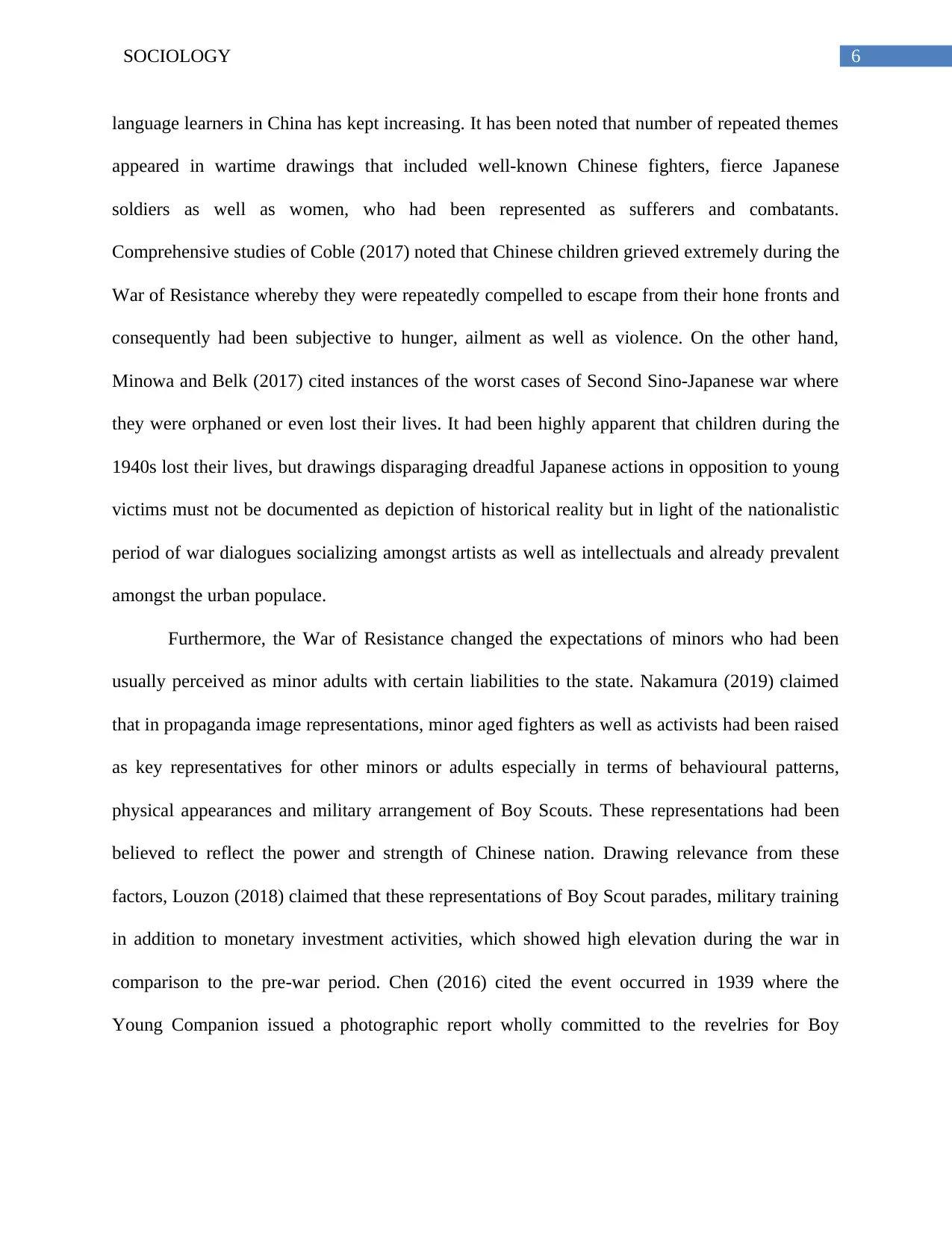
6SOCIOLOGY
language learners in China has kept increasing. It has been noted that number of repeated themes
appeared in wartime drawings that included well-known Chinese fighters, fierce Japanese
soldiers as well as women, who had been represented as sufferers and combatants.
Comprehensive studies of Coble (2017) noted that Chinese children grieved extremely during the
War of Resistance whereby they were repeatedly compelled to escape from their hone fronts and
consequently had been subjective to hunger, ailment as well as violence. On the other hand,
Minowa and Belk (2017) cited instances of the worst cases of Second Sino-Japanese war where
they were orphaned or even lost their lives. It had been highly apparent that children during the
1940s lost their lives, but drawings disparaging dreadful Japanese actions in opposition to young
victims must not be documented as depiction of historical reality but in light of the nationalistic
period of war dialogues socializing amongst artists as well as intellectuals and already prevalent
amongst the urban populace.
Furthermore, the War of Resistance changed the expectations of minors who had been
usually perceived as minor adults with certain liabilities to the state. Nakamura (2019) claimed
that in propaganda image representations, minor aged fighters as well as activists had been raised
as key representatives for other minors or adults especially in terms of behavioural patterns,
physical appearances and military arrangement of Boy Scouts. These representations had been
believed to reflect the power and strength of Chinese nation. Drawing relevance from these
factors, Louzon (2018) claimed that these representations of Boy Scout parades, military training
in addition to monetary investment activities, which showed high elevation during the war in
comparison to the pre-war period. Chen (2016) cited the event occurred in 1939 where the
Young Companion issued a photographic report wholly committed to the revelries for Boy
language learners in China has kept increasing. It has been noted that number of repeated themes
appeared in wartime drawings that included well-known Chinese fighters, fierce Japanese
soldiers as well as women, who had been represented as sufferers and combatants.
Comprehensive studies of Coble (2017) noted that Chinese children grieved extremely during the
War of Resistance whereby they were repeatedly compelled to escape from their hone fronts and
consequently had been subjective to hunger, ailment as well as violence. On the other hand,
Minowa and Belk (2017) cited instances of the worst cases of Second Sino-Japanese war where
they were orphaned or even lost their lives. It had been highly apparent that children during the
1940s lost their lives, but drawings disparaging dreadful Japanese actions in opposition to young
victims must not be documented as depiction of historical reality but in light of the nationalistic
period of war dialogues socializing amongst artists as well as intellectuals and already prevalent
amongst the urban populace.
Furthermore, the War of Resistance changed the expectations of minors who had been
usually perceived as minor adults with certain liabilities to the state. Nakamura (2019) claimed
that in propaganda image representations, minor aged fighters as well as activists had been raised
as key representatives for other minors or adults especially in terms of behavioural patterns,
physical appearances and military arrangement of Boy Scouts. These representations had been
believed to reflect the power and strength of Chinese nation. Drawing relevance from these
factors, Louzon (2018) claimed that these representations of Boy Scout parades, military training
in addition to monetary investment activities, which showed high elevation during the war in
comparison to the pre-war period. Chen (2016) cited the event occurred in 1939 where the
Young Companion issued a photographic report wholly committed to the revelries for Boy
Paraphrase This Document
Need a fresh take? Get an instant paraphrase of this document with our AI Paraphraser
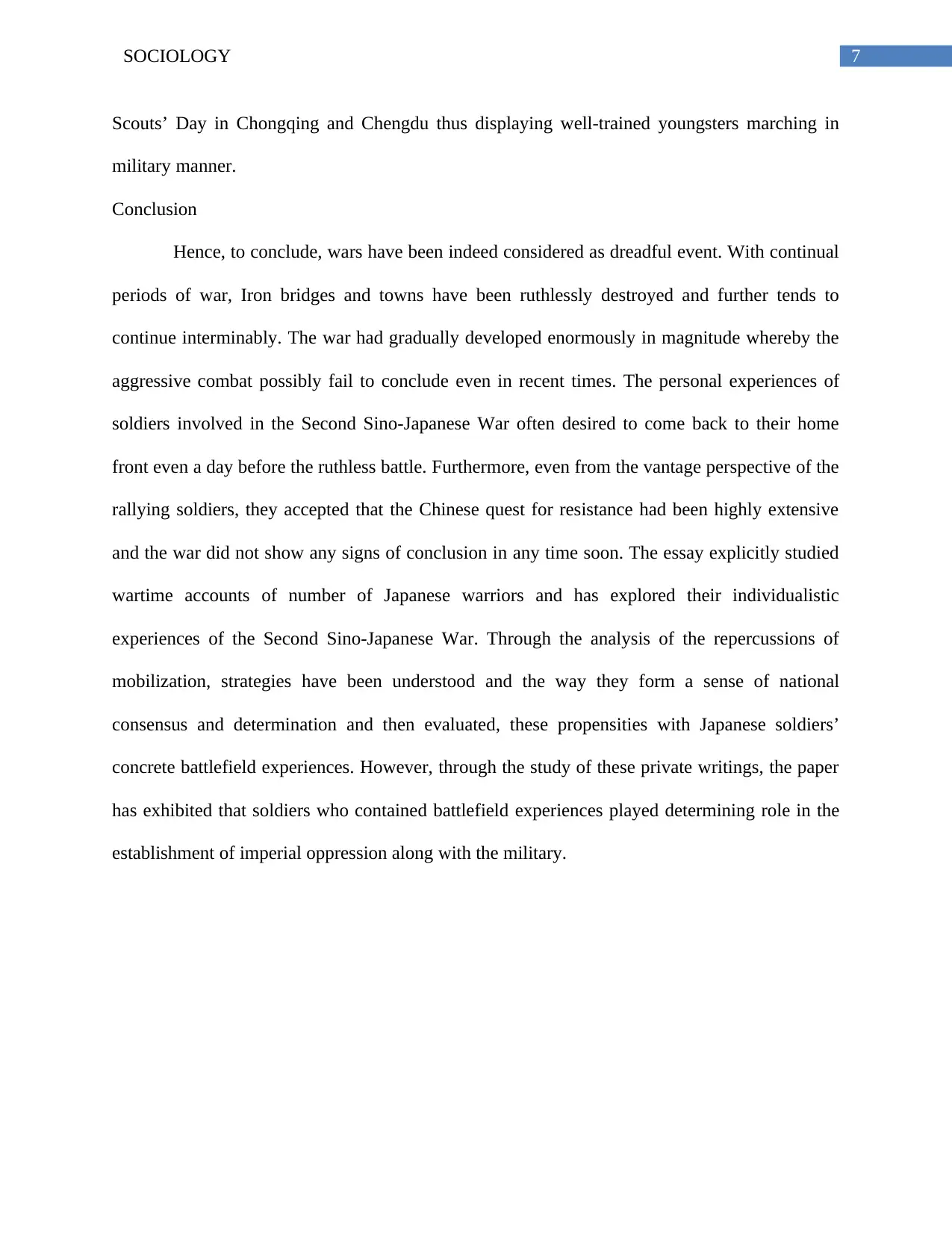
7SOCIOLOGY
Scouts’ Day in Chongqing and Chengdu thus displaying well-trained youngsters marching in
military manner.
Conclusion
Hence, to conclude, wars have been indeed considered as dreadful event. With continual
periods of war, Iron bridges and towns have been ruthlessly destroyed and further tends to
continue interminably. The war had gradually developed enormously in magnitude whereby the
aggressive combat possibly fail to conclude even in recent times. The personal experiences of
soldiers involved in the Second Sino-Japanese War often desired to come back to their home
front even a day before the ruthless battle. Furthermore, even from the vantage perspective of the
rallying soldiers, they accepted that the Chinese quest for resistance had been highly extensive
and the war did not show any signs of conclusion in any time soon. The essay explicitly studied
wartime accounts of number of Japanese warriors and has explored their individualistic
experiences of the Second Sino-Japanese War. Through the analysis of the repercussions of
mobilization, strategies have been understood and the way they form a sense of national
consensus and determination and then evaluated, these propensities with Japanese soldiers’
concrete battlefield experiences. However, through the study of these private writings, the paper
has exhibited that soldiers who contained battlefield experiences played determining role in the
establishment of imperial oppression along with the military.
Scouts’ Day in Chongqing and Chengdu thus displaying well-trained youngsters marching in
military manner.
Conclusion
Hence, to conclude, wars have been indeed considered as dreadful event. With continual
periods of war, Iron bridges and towns have been ruthlessly destroyed and further tends to
continue interminably. The war had gradually developed enormously in magnitude whereby the
aggressive combat possibly fail to conclude even in recent times. The personal experiences of
soldiers involved in the Second Sino-Japanese War often desired to come back to their home
front even a day before the ruthless battle. Furthermore, even from the vantage perspective of the
rallying soldiers, they accepted that the Chinese quest for resistance had been highly extensive
and the war did not show any signs of conclusion in any time soon. The essay explicitly studied
wartime accounts of number of Japanese warriors and has explored their individualistic
experiences of the Second Sino-Japanese War. Through the analysis of the repercussions of
mobilization, strategies have been understood and the way they form a sense of national
consensus and determination and then evaluated, these propensities with Japanese soldiers’
concrete battlefield experiences. However, through the study of these private writings, the paper
has exhibited that soldiers who contained battlefield experiences played determining role in the
establishment of imperial oppression along with the military.
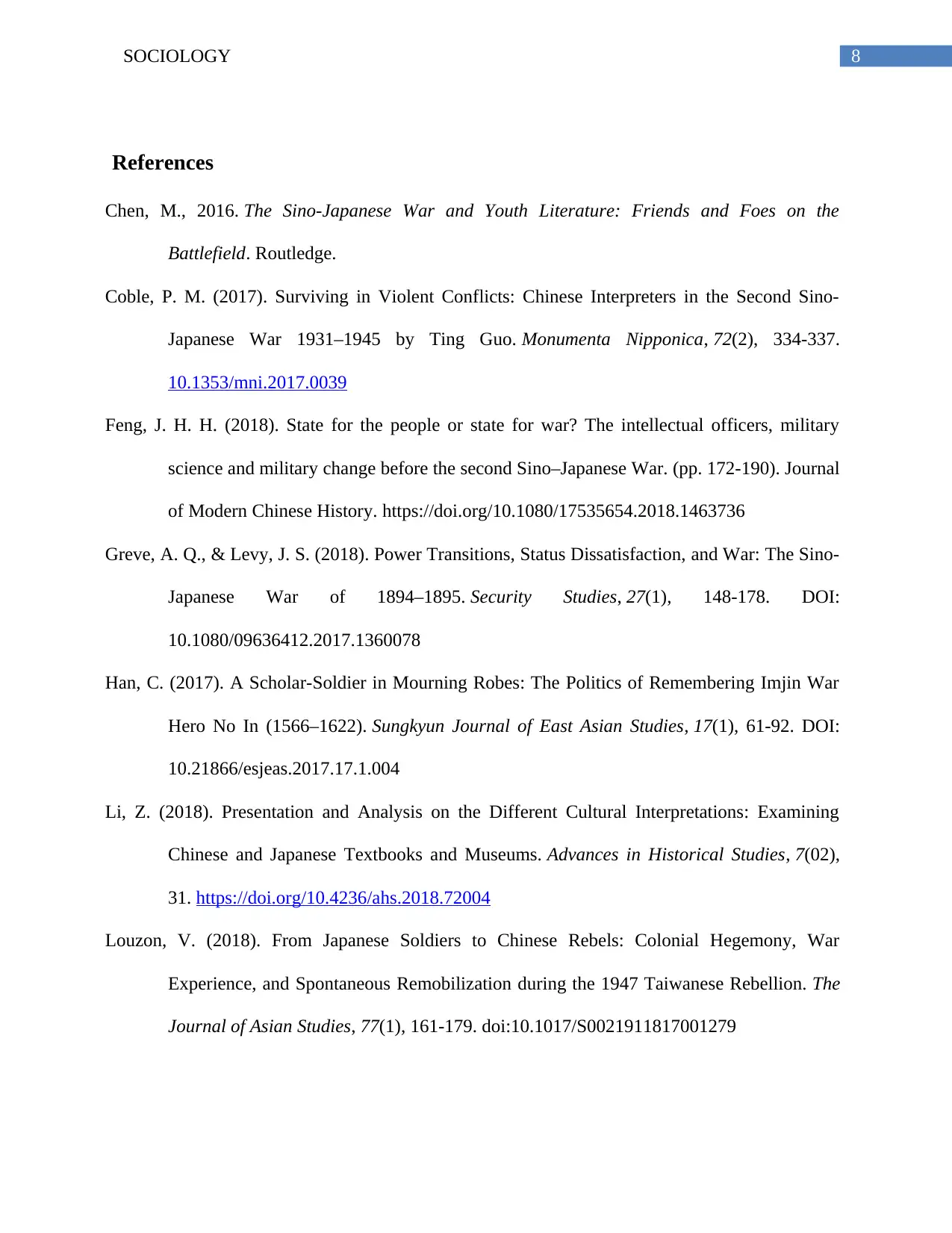
8SOCIOLOGY
References
Chen, M., 2016. The Sino-Japanese War and Youth Literature: Friends and Foes on the
Battlefield. Routledge.
Coble, P. M. (2017). Surviving in Violent Conflicts: Chinese Interpreters in the Second Sino-
Japanese War 1931–1945 by Ting Guo. Monumenta Nipponica, 72(2), 334-337.
10.1353/mni.2017.0039
Feng, J. H. H. (2018). State for the people or state for war? The intellectual officers, military
science and military change before the second Sino–Japanese War. (pp. 172-190). Journal
of Modern Chinese History. https://doi.org/10.1080/17535654.2018.1463736
Greve, A. Q., & Levy, J. S. (2018). Power Transitions, Status Dissatisfaction, and War: The Sino-
Japanese War of 1894–1895. Security Studies, 27(1), 148-178. DOI:
10.1080/09636412.2017.1360078
Han, C. (2017). A Scholar-Soldier in Mourning Robes: The Politics of Remembering Imjin War
Hero No In (1566–1622). Sungkyun Journal of East Asian Studies, 17(1), 61-92. DOI:
10.21866/esjeas.2017.17.1.004
Li, Z. (2018). Presentation and Analysis on the Different Cultural Interpretations: Examining
Chinese and Japanese Textbooks and Museums. Advances in Historical Studies, 7(02),
31. https://doi.org/10.4236/ahs.2018.72004
Louzon, V. (2018). From Japanese Soldiers to Chinese Rebels: Colonial Hegemony, War
Experience, and Spontaneous Remobilization during the 1947 Taiwanese Rebellion. The
Journal of Asian Studies, 77(1), 161-179. doi:10.1017/S0021911817001279
References
Chen, M., 2016. The Sino-Japanese War and Youth Literature: Friends and Foes on the
Battlefield. Routledge.
Coble, P. M. (2017). Surviving in Violent Conflicts: Chinese Interpreters in the Second Sino-
Japanese War 1931–1945 by Ting Guo. Monumenta Nipponica, 72(2), 334-337.
10.1353/mni.2017.0039
Feng, J. H. H. (2018). State for the people or state for war? The intellectual officers, military
science and military change before the second Sino–Japanese War. (pp. 172-190). Journal
of Modern Chinese History. https://doi.org/10.1080/17535654.2018.1463736
Greve, A. Q., & Levy, J. S. (2018). Power Transitions, Status Dissatisfaction, and War: The Sino-
Japanese War of 1894–1895. Security Studies, 27(1), 148-178. DOI:
10.1080/09636412.2017.1360078
Han, C. (2017). A Scholar-Soldier in Mourning Robes: The Politics of Remembering Imjin War
Hero No In (1566–1622). Sungkyun Journal of East Asian Studies, 17(1), 61-92. DOI:
10.21866/esjeas.2017.17.1.004
Li, Z. (2018). Presentation and Analysis on the Different Cultural Interpretations: Examining
Chinese and Japanese Textbooks and Museums. Advances in Historical Studies, 7(02),
31. https://doi.org/10.4236/ahs.2018.72004
Louzon, V. (2018). From Japanese Soldiers to Chinese Rebels: Colonial Hegemony, War
Experience, and Spontaneous Remobilization during the 1947 Taiwanese Rebellion. The
Journal of Asian Studies, 77(1), 161-179. doi:10.1017/S0021911817001279
⊘ This is a preview!⊘
Do you want full access?
Subscribe today to unlock all pages.

Trusted by 1+ million students worldwide
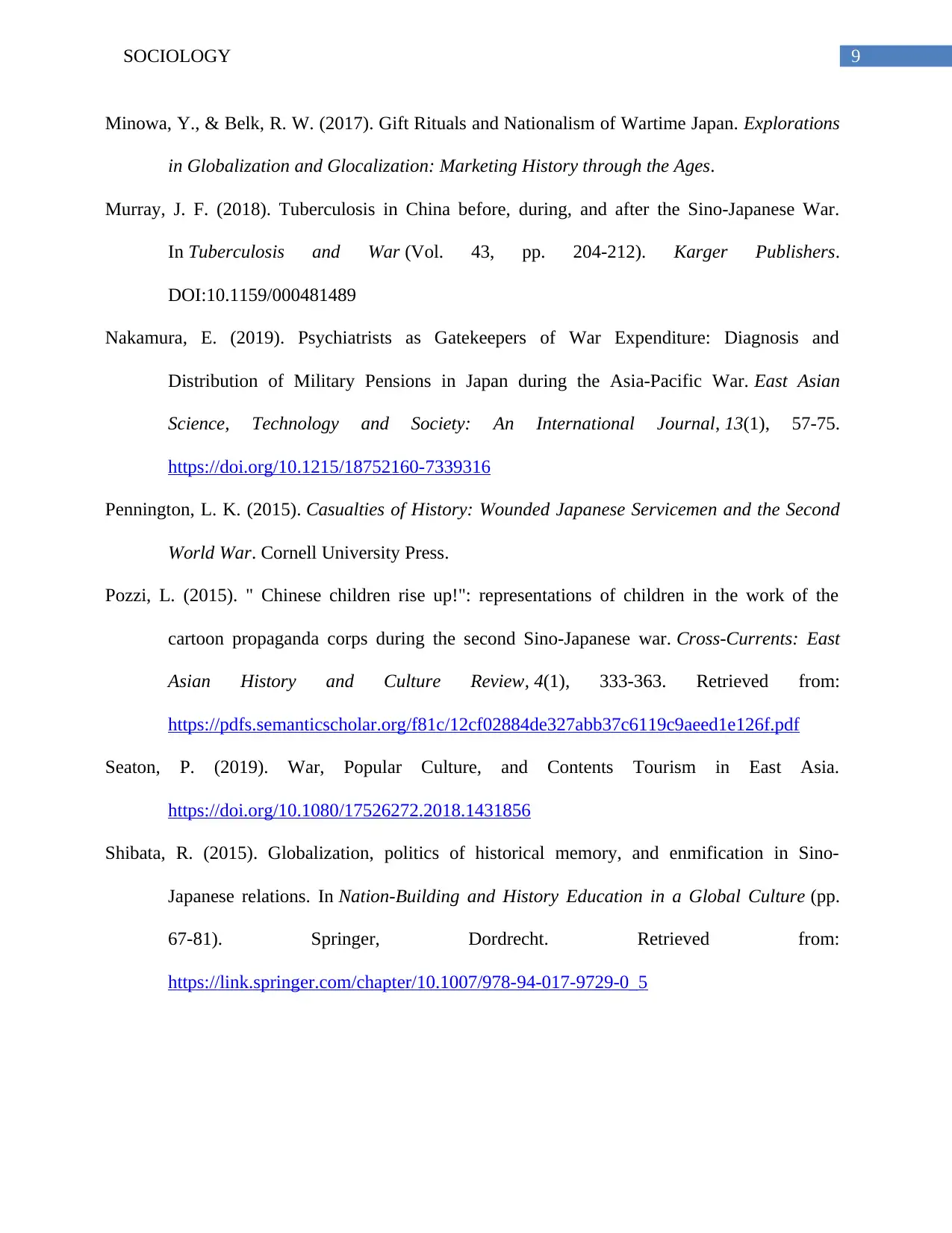
9SOCIOLOGY
Minowa, Y., & Belk, R. W. (2017). Gift Rituals and Nationalism of Wartime Japan. Explorations
in Globalization and Glocalization: Marketing History through the Ages.
Murray, J. F. (2018). Tuberculosis in China before, during, and after the Sino-Japanese War.
In Tuberculosis and War (Vol. 43, pp. 204-212). Karger Publishers.
DOI:10.1159/000481489
Nakamura, E. (2019). Psychiatrists as Gatekeepers of War Expenditure: Diagnosis and
Distribution of Military Pensions in Japan during the Asia-Pacific War. East Asian
Science, Technology and Society: An International Journal, 13(1), 57-75.
https://doi.org/10.1215/18752160-7339316
Pennington, L. K. (2015). Casualties of History: Wounded Japanese Servicemen and the Second
World War. Cornell University Press.
Pozzi, L. (2015). " Chinese children rise up!": representations of children in the work of the
cartoon propaganda corps during the second Sino-Japanese war. Cross-Currents: East
Asian History and Culture Review, 4(1), 333-363. Retrieved from:
https://pdfs.semanticscholar.org/f81c/12cf02884de327abb37c6119c9aeed1e126f.pdf
Seaton, P. (2019). War, Popular Culture, and Contents Tourism in East Asia.
https://doi.org/10.1080/17526272.2018.1431856
Shibata, R. (2015). Globalization, politics of historical memory, and enmification in Sino-
Japanese relations. In Nation-Building and History Education in a Global Culture (pp.
67-81). Springer, Dordrecht. Retrieved from:
https://link.springer.com/chapter/10.1007/978-94-017-9729-0_5
Minowa, Y., & Belk, R. W. (2017). Gift Rituals and Nationalism of Wartime Japan. Explorations
in Globalization and Glocalization: Marketing History through the Ages.
Murray, J. F. (2018). Tuberculosis in China before, during, and after the Sino-Japanese War.
In Tuberculosis and War (Vol. 43, pp. 204-212). Karger Publishers.
DOI:10.1159/000481489
Nakamura, E. (2019). Psychiatrists as Gatekeepers of War Expenditure: Diagnosis and
Distribution of Military Pensions in Japan during the Asia-Pacific War. East Asian
Science, Technology and Society: An International Journal, 13(1), 57-75.
https://doi.org/10.1215/18752160-7339316
Pennington, L. K. (2015). Casualties of History: Wounded Japanese Servicemen and the Second
World War. Cornell University Press.
Pozzi, L. (2015). " Chinese children rise up!": representations of children in the work of the
cartoon propaganda corps during the second Sino-Japanese war. Cross-Currents: East
Asian History and Culture Review, 4(1), 333-363. Retrieved from:
https://pdfs.semanticscholar.org/f81c/12cf02884de327abb37c6119c9aeed1e126f.pdf
Seaton, P. (2019). War, Popular Culture, and Contents Tourism in East Asia.
https://doi.org/10.1080/17526272.2018.1431856
Shibata, R. (2015). Globalization, politics of historical memory, and enmification in Sino-
Japanese relations. In Nation-Building and History Education in a Global Culture (pp.
67-81). Springer, Dordrecht. Retrieved from:
https://link.springer.com/chapter/10.1007/978-94-017-9729-0_5
Paraphrase This Document
Need a fresh take? Get an instant paraphrase of this document with our AI Paraphraser
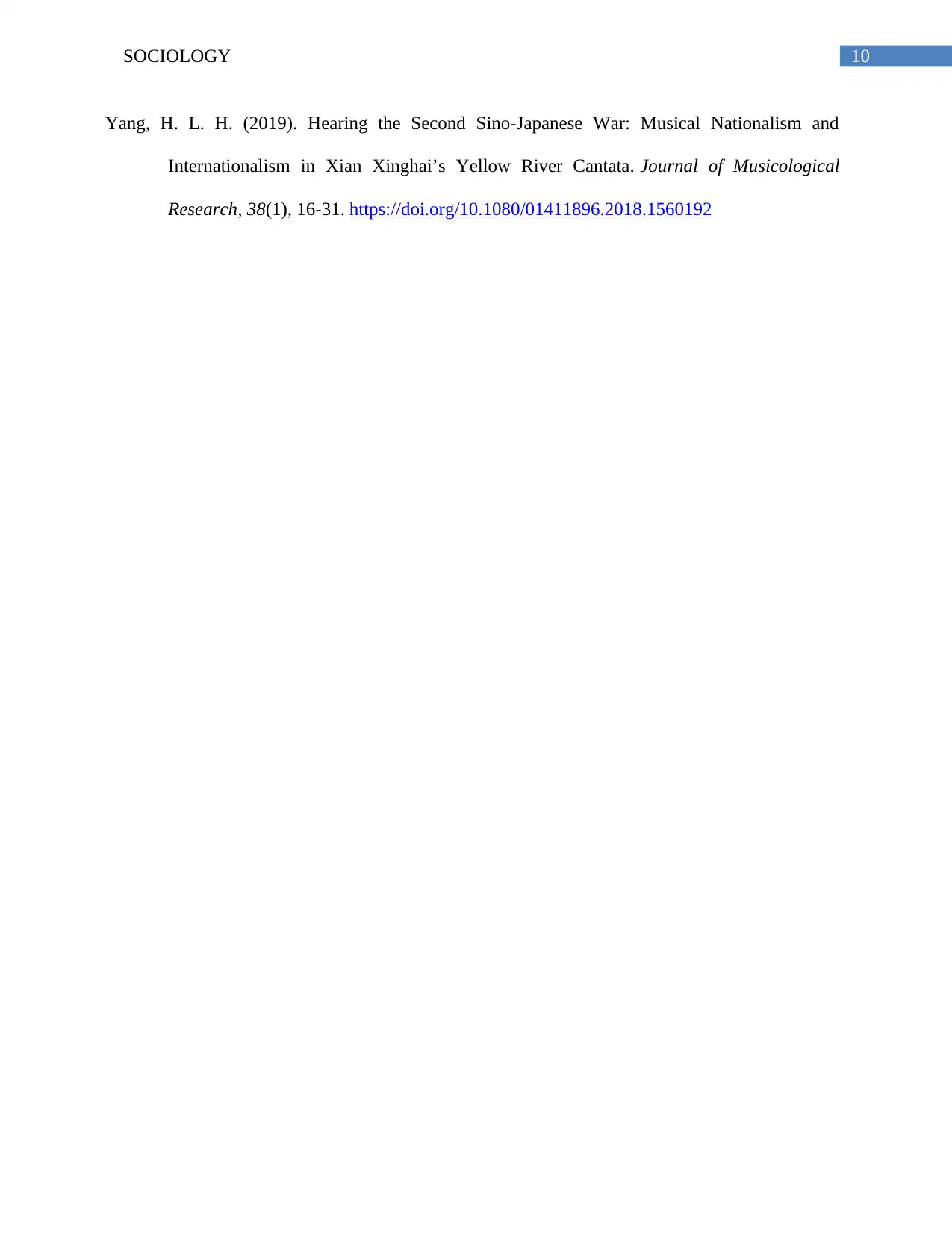
10SOCIOLOGY
Yang, H. L. H. (2019). Hearing the Second Sino-Japanese War: Musical Nationalism and
Internationalism in Xian Xinghai’s Yellow River Cantata. Journal of Musicological
Research, 38(1), 16-31. https://doi.org/10.1080/01411896.2018.1560192
Yang, H. L. H. (2019). Hearing the Second Sino-Japanese War: Musical Nationalism and
Internationalism in Xian Xinghai’s Yellow River Cantata. Journal of Musicological
Research, 38(1), 16-31. https://doi.org/10.1080/01411896.2018.1560192
1 out of 11
Your All-in-One AI-Powered Toolkit for Academic Success.
+13062052269
info@desklib.com
Available 24*7 on WhatsApp / Email
![[object Object]](/_next/static/media/star-bottom.7253800d.svg)
Unlock your academic potential
Copyright © 2020–2025 A2Z Services. All Rights Reserved. Developed and managed by ZUCOL.